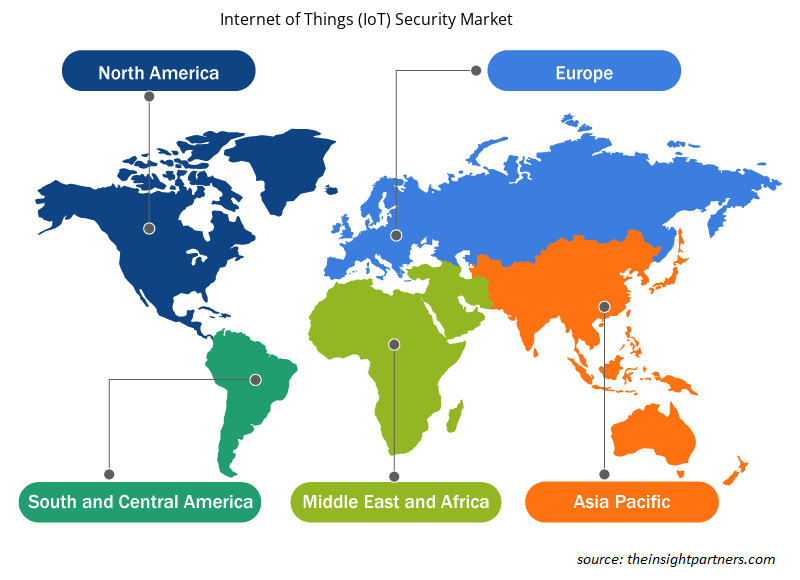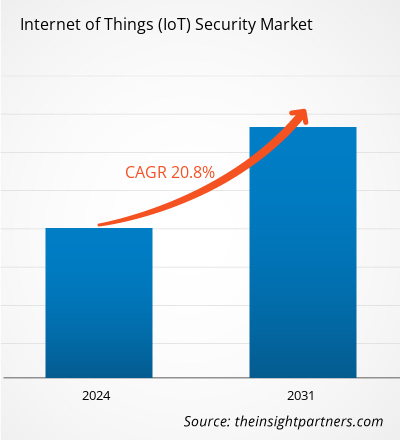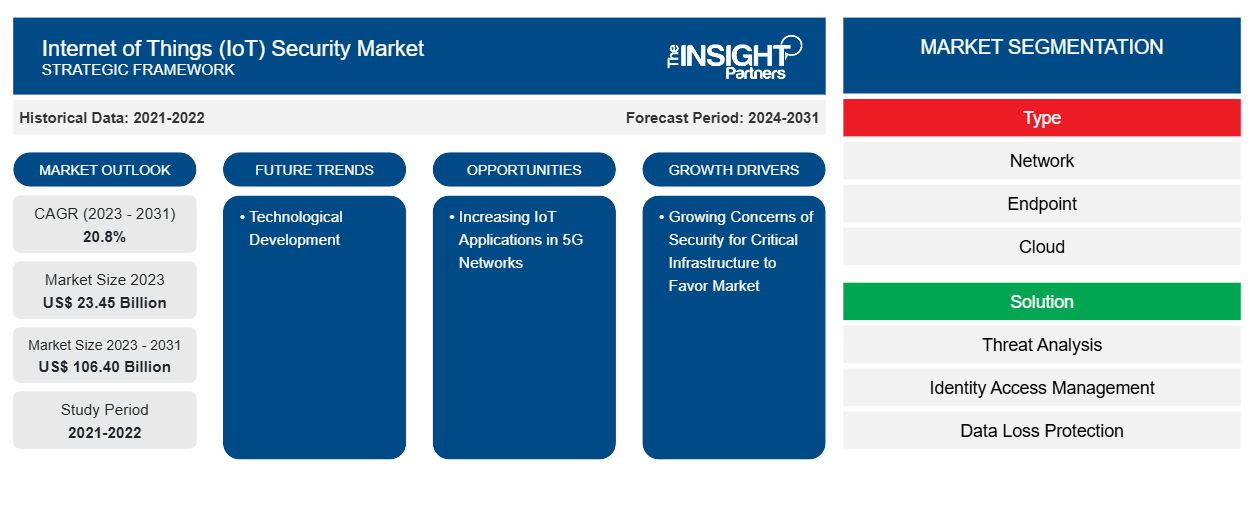사물 인터넷(IoT) 보안 시장 규모는 2023년 234억 5천만 달러에서 2031년 1,064억 달러로 성장할 것으로 예상됩니다. 이 시장은 2023-2031년에 20.8%의 CAGR을 기록할 것으로 예상됩니다. 중요 인프라의 보안에 대한 우려가 커지고 스마트 시티가 성장하면서 IoT 보안 시장이 성장하고 있습니다.
사물인터넷(IoT) 보안 시장 분석
사물 인터넷(IoT) 보안 시장을 움직이는 주요 요인은 여러 가지가 있습니다. 여러 요인이 이러한 성장을 주도하고 있습니다. 그 중 하나는 사이버 회복력 강화의 필요성을 강조하는 Industry 4.0 IoT 보안 사고의 증가입니다. 이러한 IoT 취약성은 해커에게 악용할 새로운 경로, IoT 보안 규정의 증가, 중요 인프라에 대한 보안 우려의 증가를 제공합니다.
사물인터넷(IoT) 보안 시장 개요
해커의 데이터 도난 및 데이터 왜곡으로부터 IoT 기기 와 네트워크를 보호하는 것을 IoT(사물 인터넷) 보안이라고 합니다. 필요한/차세대 보안 조치를 견고하게 설치하고, 투명성을 강화하며, 사용자에게 데이터 수집을 거부할 수 있는 옵션을 부여하여 인터넷 연결 기기의 미래를 보호해야 하는 필요성은 예측 기간 동안 시장을 주도하는 주요 이유 중 하나입니다.
귀하의 요구 사항에 맞게 이 보고서를 사용자 정의하세요
이 보고서의 일부 또는 국가 수준 분석, Excel 데이터 팩을 포함하여 모든 보고서에 대한 사용자 정의를 무료로 받을 수 있으며 신생 기업 및 대학을 위한 훌륭한 혜택과 할인 혜택을 이용할 수 있습니다.
- 이 보고서의 주요 시장 동향을 알아보세요.이 무료 샘플에는 시장 동향부터 추정 및 예측까지 다양한 데이터 분석이 포함됩니다.
사물인터넷(IoT) 보안 시장 동인 및 기회
중요 인프라 보안에 대한 우려가 커지면서 시장이 유리해지고 있습니다.
해커들은 사물 인터넷(IoT) 기기에 집중하고 비밀번호, 기본 사용자 이름, 정적 코드 백도어와 같은 잘 알려진 결함을 이용하고 있습니다. 모든 산업은 IoT 통합을 통해 현대 세계에서 자동화를 받아들이고 있습니다. 사물 인터넷 의 초기 채택자 , 물, 전력 및 기타 리소스와 같은 필수 인프라는 현재 자동화되고 있습니다.
자동화는 운영 효율성을 크게 높이지만, 사이버 공격에 취약한 시스템을 남겨둡니다. 증가하는 시스템 취약성은 정부에 대한 세계 최대의 우려로 부상했습니다. 원자로의 제어는 의도적이거나 악의적으로 조작될 경우 인명과 재산에 심각한 위험을 초래합니다.
5G 네트워크에서 IoT 애플리케이션 증가
멀티 액세스 엣지 컴퓨팅(MEC)과 5G의 낮은 대기 시간은 IoT 지원 스마트 팩토리에서 출력을 최적화하는 데 도움이 됩니다. ICT 부문은 5G 기술 덕분에 IoT 서비스와 애플리케이션을 더 빠르게 도입하고 있습니다. 광산과 커넥티드 카 같은 대규모 원거리 지역에서 5G는 원격 모니터링, 시각 검사 및 자율 운영에서 새로운 사용 사례를 열 것으로 예상됩니다.
사물인터넷(IoT) 보안 시장 보고서 세분화 분석
사물인터넷(IoT) 보안 시장 분석에 기여한 주요 세그먼트는 유형, 솔루션, 애플리케이션입니다.
- 사물 인터넷(IoT) 보안 시장은 유형에 따라 네트워크, 엔드포인트, 클라우드, 애플리케이션 보안 및 기타로 구분됩니다. 클라우드 세그먼트는 예측 기간 동안 성장할 것으로 예상됩니다.
- 솔루션별로 시장은 위협 분석, ID 액세스 관리, 데이터 손실 보호, 암호화, 디스패치 및 사고 대응, 분산 서비스 거부 보호 및 기타로 세분화됩니다. ID 액세스 관리 세그먼트는 예측 기간 동안 성장할 것으로 예상됩니다.
- 응용 프로그램을 기준으로 사물 인터넷(IoT) 보안 시장은 스마트 홈, 커넥티드 카, 정보 및 통신 기술, 스마트 팩토리, BFSI, 스마트 리테일, 스마트 헬스케어, 스마트 운송, 웨어러블 등으로 구분됩니다. 정보 및 통신 기술 부문은 예측 기간 동안 성장할 것으로 예상됩니다.
지역별 사물인터넷(IoT) 보안 시장 점유율 분석
사물 인터넷(IoT) 보안 시장 보고서의 지리적 범위는 주로 북미, 아시아 태평양, 유럽, 중동 및 아프리카, 남미/남중부 및 남미의 5개 지역으로 나뉩니다. 북미는 사물 인터넷(IoT) 보안 시장을 지배해 왔습니다. 북미 지역의 다양한 산업에서 첨단 기술 도입 추세가 사물 인터넷(IoT) 보안 시장의 성장을 촉진했습니다. 디지털 도구 도입 증가 및 정부 기관의 높은 기술 지출과 같은 요인이 북미 사물 인터넷(IoT) 보안 시장 성장을 촉진할 것으로 예상됩니다. 게다가 미국과 캐나다의 선진 경제권에서 연구 개발에 중점을 두면서 북미 업체는 기술적으로 진보된 솔루션을 시장에 출시해야 합니다. 게다가 미국에는 혁신적인 솔루션 개발에 점점 더 주력하고 있는 많은 사물 인터넷(IoT) 보안 시장 업체가 있습니다. 이러한 모든 요인이 이 지역의 사물 인터넷(IoT) 보안 시장 성장에 기여합니다.
사물인터넷(IoT) 보안 시장 지역 통찰력
Insight Partners의 분석가들은 예측 기간 동안 사물 인터넷(IoT) 보안 시장에 영향을 미치는 지역적 추세와 요인을 철저히 설명했습니다. 이 섹션에서는 북미, 유럽, 아시아 태평양, 중동 및 아프리카, 남미 및 중미의 사물 인터넷(IoT) 보안 시장 세그먼트와 지리에 대해서도 설명합니다.

- 사물인터넷(IoT) 보안 시장에 대한 지역별 데이터 얻기
사물인터넷(IoT) 보안 시장 보고서 범위
| 보고서 속성 | 세부 |
|---|---|
| 2023년 시장 규모 | 234억 5천만 달러 |
| 2031년까지 시장 규모 | 1,064억 달러 |
| 글로벌 CAGR (2023-2031) | 20.8% |
| 역사적 데이터 | 2021-2022 |
| 예측 기간 | 2024-2031 |
| 다루는 세그먼트 | 유형별로
|
| 포함된 지역 및 국가 | 북아메리카
|
| 시장 선도 기업 및 주요 회사 프로필 |
|
사물 인터넷(IoT) 보안 시장 참여자 밀도: 비즈니스 역학에 미치는 영향 이해
사물 인터넷(IoT) 보안 시장은 소비자 선호도의 변화, 기술 발전, 제품의 이점에 대한 인식 증가와 같은 요인으로 인해 최종 사용자 수요가 증가함에 따라 빠르게 성장하고 있습니다. 수요가 증가함에 따라 기업은 제품을 확장하고, 소비자의 요구를 충족하기 위해 혁신하고, 새로운 트렌드를 활용하여 시장 성장을 더욱 촉진하고 있습니다.
시장 참여자 밀도는 특정 시장이나 산업 내에서 운영되는 회사나 기업의 분포를 말합니다. 주어진 시장 공간에 얼마나 많은 경쟁자(시장 참여자)가 존재하는지 그 규모나 전체 시장 가치에 비해 나타냅니다.
사물인터넷(IoT) 보안 시장에서 운영되는 주요 회사는 다음과 같습니다.
- IBM 주식회사
- 마이크로소프트
- 아마존 웹 서비스
- 인텔
- 시스코
면책 조항 : 위에 나열된 회사는 어떤 특별한 순서에 따라 순위가 매겨지지 않았습니다.

- 사물인터넷(IoT) 보안 시장의 주요 기업 개요를 알아보세요
사물인터넷(IoT) 보안 시장 뉴스 및 최근 개발
사물 인터넷(IoT) 보안 시장은 1차 및 2차 조사 이후의 정성적, 정량적 데이터를 수집하여 평가되며, 여기에는 중요한 기업 간행물, 협회 데이터 및 데이터베이스가 포함됩니다. 다음은 시장의 개발 목록입니다.
- 2024년 3월, OT 및 IoT 보안 분야의 선두주자인 Nozomi Networks Inc.는 프로세스 제조업체의 고유한 OT 및 IoT 사이버 보안 요구 사항을 전체적으로 충족하도록 설계된 관리형 보안 서비스 및 솔루션에 대한 글로벌 수요를 해결하기 위해 Yokogawa Electric Corporation과의 파트너십을 확대한다고 발표했습니다. Yokogawa는 Yokogawa의 OpreX Managed Services의 일부로 전 세계 고객에게 OT 및 IoT 가시성, 네트워크 모니터링 및 위협 탐지를 위한 Nozomi Networks의 고급 솔루션을 제공합니다. Yokogawa는 또한 자체적으로 보안 프로그램을 관리하는 고객에게 Nozomi Networks의 독립형 솔루션을 재판매할 것입니다.
(출처: 노조미네트웍스 주식회사, 보도자료, 2024)
사물 인터넷(IoT) 보안 시장 보고서 범위 및 제공물
"사물인터넷(IoT) 보안 시장 규모 및 예측(2021-2031)" 보고서는 아래 영역을 포괄하는 시장에 대한 자세한 분석을 제공합니다.
- 범위에 포함된 모든 주요 시장 부문에 대한 글로벌, 지역 및 국가 수준의 시장 규모와 예측입니다.
- 동인, 제약 및 주요 기회와 같은 시장 역학
- 주요 미래 트렌드
- 자세한 PEST/포터의 5가지 힘과 SWOT 분석
- 주요 시장 동향, 주요 업체, 규정, 최근 시장 개발 사항을 다루는 글로벌 및 지역 시장 분석입니다.
- 시장 집중도, 히트맵 분석, 주요 업체, 최근 개발 사항을 포괄하는 업계 환경 및 경쟁 분석입니다.
- 자세한 회사 프로필
- 과거 분석(2년), 기준 연도, CAGR을 포함한 예측(7년)
- PEST 및 SWOT 분석
- 시장 규모 가치/거래량 - 글로벌, 지역, 국가
- 산업 및 경쟁 환경
- Excel 데이터세트
최근 보고서
사용 후기
구매 이유
- 정보에 기반한 의사 결정
- 시장 역학 이해
- 경쟁 분석
- 고객 인사이트
- 시장 예측
- 위험 완화
- 전략 기획
- 투자 타당성 분석
- 신흥 시장 파악
- 마케팅 전략 강화
- 운영 효율성 향상
- 규제 동향에 발맞춰 대응





















 무료 샘플 받기 - 사물인터넷(IoT) 보안 시장
무료 샘플 받기 - 사물인터넷(IoT) 보안 시장